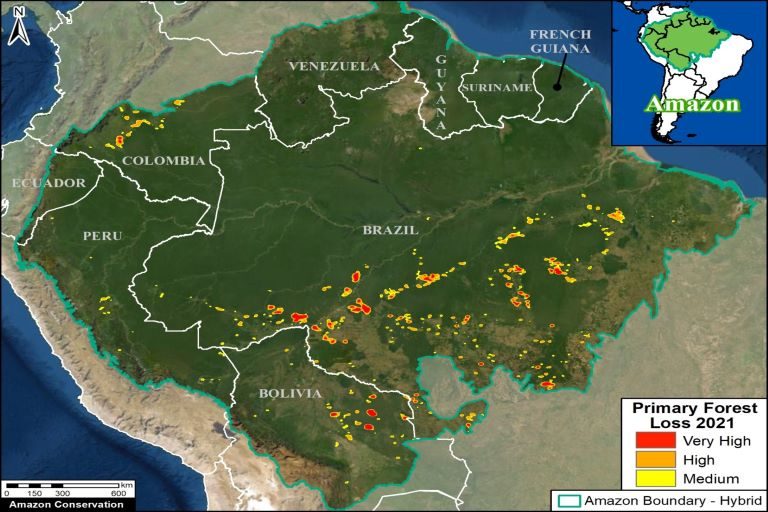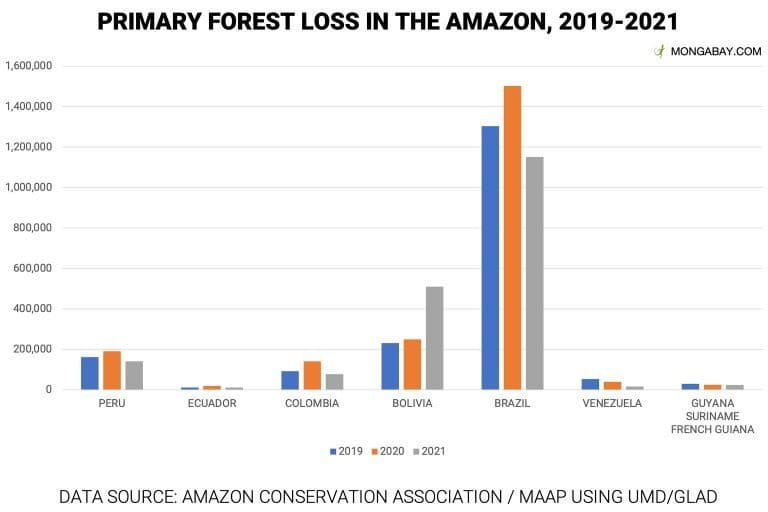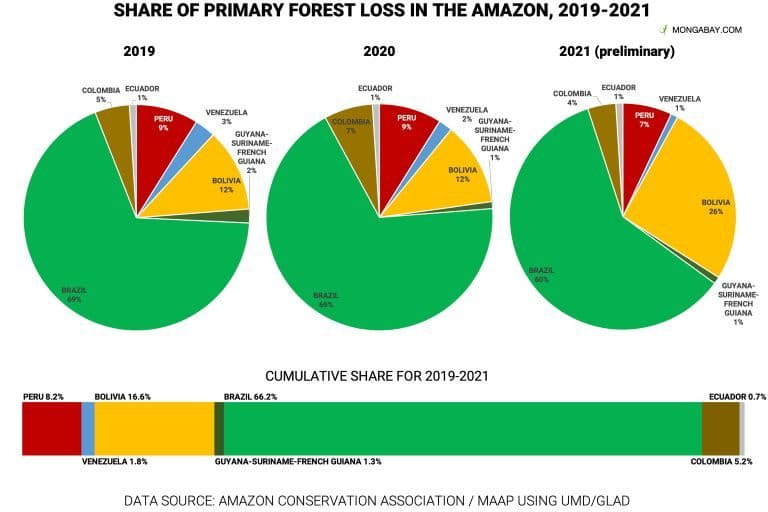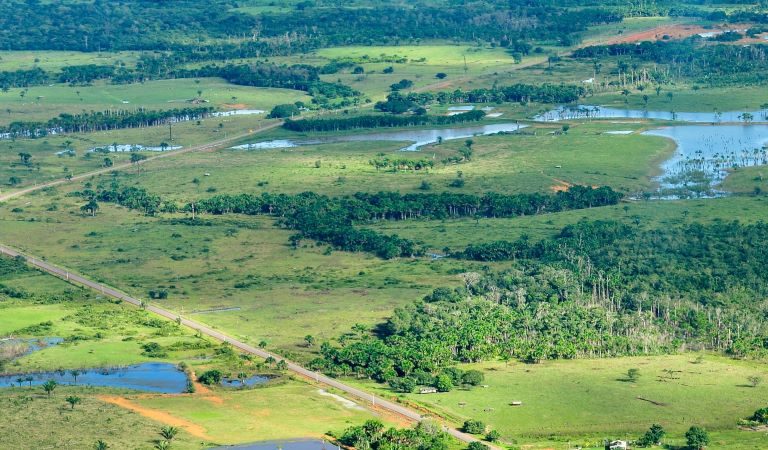2021 Amazon Deforestation Map Shows Devastating Impact of Ranching, Agriculture
ENVIRONMENT, 28 Mar 2022
Maxwell Radwin | Mongabay - TRANSCEND Media Service
- Amazon Conservation’s Monitoring of the Andean Amazon Project (MAAP) found that around 1.9 million hectares (4.8 million acres) of the Amazon were lost last year, mostly in Brazil and Bolivia.
- The mapping data shine a light on the different causes of deforestation in each country, including agriculture, cattle ranching and road construction.
- The data also provide some positive takeaways, such as Peru’s successful crackdown on illegal mining, and a contiguous core section of Amazonian forest still acting as a carbon sink.
21 Mar 2022 – The Amazon lost millions of hectares of primary forest in 2021, mostly as the result of cattle ranching and other agricultural activities, a new report reveals.
Amazon Conservation’s Monitoring of the Andean Amazon Project (MAAP) found that around 1.9 million hectares (4.8 million acres) of the rainforest were lost last year, similar to annual forest loss rates in 2020 and 2019.
Most of the deforestation took place in Brazil, with Bolivia suffering the second-highest losses. Colombia and Peru also saw noticeable forest loss.
The results are based on University of Maryland satellite data that detect deforestation hotspots. The report compiled raw forest loss data to produce the 2021 hotspot map. Final annual data will come out later this year as additional analysis is done on more thorough satellite readings.

Mapping the devastation
MAAP’s findings suggest that most deforestation in Brazil is happening along major roads through the eastern and southeastern states of Acre, Amazonas, Pará and Rondônia. These states are major hotspots for legal and illegal cattle ranching activity, as well as other agricultural production that relies on roads — most notably highways 163, 230, 319 and 364 — for moving goods in and out of the forest.
The report indicates that deforestation in Brazil isn’t happening in one massive wave but is instead chipping away along major roads in several parts of the country.
“We know from historical precedence that whenever you open up roads in these ecologically sensitive biomes, you’re literally opening routes for all kinds of illegal activities, including illegal deforestation but also land invasions of Indigenous land,” Adriana Abdenur, of Plataforma CIPÓ, a climate, governance and peace-building think tank in Latin America, told Mongabay.
She added, “Whenever you see a road opening up previously pristine or even secondary forest, that’s generally a good predictor that a whole range of illegal activities are likely to take place in that area.”

The maps for other parts of the Amazon biome, meanwhile, reveal other major drivers. In the Peruvian Amazon, for example, most primary forest loss didn’t occur along major roads but instead in a concentrated area where Mennonite settlements have been expanding.
Clearing by Mennonites is the new leading cause of deforestation in Peru, Mongabay reported last year. Since 2017, newly arriving colonies have cleared thousands of hectares of primary forest to set up farms and homes.
In the Bolivian Amazon, satellite readings show a more scattered pattern of deforestation throughout the southeastern Chiquitano dry forest. Unlike the moister parts of the biome in Brazil, the area is dry enough that farmers and ranchers lose control of fires more often, which then spread to primary forest.

“You get a lot of ‘escaped’ fires,” said Matt Finer, the MAAP director and senior research specialist at Amazon Conservation. “You can really see the concentration of fire impacts in the dry forest of the southeast Bolivian Amazon.”
Another arc of deforestation, this one in the Colombian Amazon, has raised alarms among conservationists because much of it penetrates protected areas like Chiribiquete National Park, where more than 6,000 hectares (14,800 acres) of forest have been lost since 2018, MAAP estimates.
Cattle ranching and small-scale subsistence agriculture — often the result of land grabbing in and around protected areas — are the main drivers of deforestation in Colombia, Finer said.

Some silver linings
While MAAP’s report suggests deforestation rates didn’t improve last year and fire patterns suggest that future threats aren’t going away anytime soon, there are a few reasons to be hopeful about Amazon conservation in 2022 and beyond.
For example, the readings in Peru show significantly less deforestation in the Madre de Dios region than in years past. Historically, this region has struggled with illegal gold mining, logging and coca cultivation, among other deforestation drivers.
But in 2019, the Peruvian government launched Operation Mercury to eliminate illegal gold mining activities that were contributing to primary forest loss. In the most critical mining areas, deforestation decreased by around 90%, according to MAAP. In the broader region, it decreased by 78%.
Another positive takeaway is that most deforestation in the Amazon appears to be happening in the south, southeast and northwest parts of the biome, leaving a large, contiguous piece of forest in the central and northeast Amazon, which is holding the biome together, Finer said.
“This map really shows, on the positive, all the green that still represents the core Amazon that 50 years from now, will determine the state of the Amazon,” he said, “[depending on] how well we preserve that core.”

In addition to northeastern Brazil, much of that area falls within Venezuela, Guyana, Suriname and French Guiana. The MAAP team found Amazon deforestation in these countries was relatively low compared to other parts of the biome.
But Finer cautioned that even though deforestation in the northern Amazon may not be happening on the same scale, protecting the region from cattle ranching, agriculture and development is still critical.
“If we start building any of these cross-cutting roads — a road connecting Brazil with Peru — if that stuff starts to happen, if we start to lose the core Amazon, we’re in trouble,” he said.
_________________________________________________
Max Radwin is a staff writer covering Latin America for Mongabay.
Go to Original – news.mongabay.com
Tags: Amazonia, BRICS, Bolsonaro, Brazil, CO2, Carbon source, Cattle and Ranch Farmers, Climate Change, Corruption, Deforestation, Environment, Forest fires, Global warming, Greenpeace, Human Rights, Indigenous Rights, JBS, Latin America Caribbean, Meat Industry, Nature's Rights, Rain Forests, Resources, Violent conflict
DISCLAIMER: The statements, views and opinions expressed in pieces republished here are solely those of the authors and do not necessarily represent those of TMS. In accordance with title 17 U.S.C. section 107, this material is distributed without profit to those who have expressed a prior interest in receiving the included information for research and educational purposes. TMS has no affiliation whatsoever with the originator of this article nor is TMS endorsed or sponsored by the originator. “GO TO ORIGINAL” links are provided as a convenience to our readers and allow for verification of authenticity. However, as originating pages are often updated by their originating host sites, the versions posted may not match the versions our readers view when clicking the “GO TO ORIGINAL” links. This site contains copyrighted material the use of which has not always been specifically authorized by the copyright owner. We are making such material available in our efforts to advance understanding of environmental, political, human rights, economic, democracy, scientific, and social justice issues, etc. We believe this constitutes a ‘fair use’ of any such copyrighted material as provided for in section 107 of the US Copyright Law. In accordance with Title 17 U.S.C. Section 107, the material on this site is distributed without profit to those who have expressed a prior interest in receiving the included information for research and educational purposes. For more information go to: http://www.law.cornell.edu/uscode/17/107.shtml. If you wish to use copyrighted material from this site for purposes of your own that go beyond ‘fair use’, you must obtain permission from the copyright owner.
